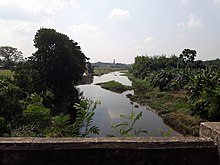Saptagram
 Saraswati River at Saptagram | |
 Location of Gauḍa in West Bengal, India | |
| Alternative name | Satgaon |
|---|---|
| Location | Hooghly district, West Bengal, India |
| Coordinates | 22°58′00″N 88°23′00″E / 22.9667°N 88.3833°ECoordinates: 22°58′00″N 88°23′00″E / 22.9667°N 88.3833°E |
| Type | Port, settlement |
| History | |
| Founded | Prior to 9th century |
| Abandoned | Started declining 17-18th century |
Saptagram (colloquially called Satgaon) was a major port, the chief city and sometimes capital of southern Bengal, in ancient and medieval times, the location presently being in the Hooghly district in the Indian state of West Bengal. It is about 4 km from Bandel, a major rail junction. By the early twentieth century, the place had dwindled to a group of insignificant huts.[1] The port had to be abandoned because of the silting up and consequent drying of the .
Etymology[]
The word Saptagram means seven villages. These are identified as Bansberia, Kristapur, Basudebpur, Nityanandapur, Sibpur, Sambachora and Baladghati.[2][3]
R: rural/ urban centre, F: facility, H: historical site
Owing to space constraints in the small map, the actual locations in a larger map may vary slightly
<
History[]
This section needs expansion. You can help by . (September 2021) |
According to Binoy Ghosh, Tamralipta, the ancient port, started declining from the 8th century, owing to river silting, and Saptagram possibly started gaining in importance as a port from the 9-10th century. Saptagram port, along with its business centre, had become important in the pre-Muslim era, during the rule of the Palas and Senas. In the Muslim era, Saptagram was an important administrative centre right from the beginning, and the period 14th to 16th century was considered the golden age of Saptagram. In the 17th century, Hooghly-Bandel-Chinsurah started gaining in importance. From the 18th century, Kolkata started emerging as the main business and cultural centre of Bengal.[4]
See also[]
- European colonies in India
- Saptagram (Vidhan Sabha constituency)
References[]
- ^ Cotton, H.E.A., Calcutta Old and New, 1909/1980, p. 2, General Printers and Publishers Pvt. Ltd.
- ^ "Temples of Bengal". Saptagram. hindubooks.org. Retrieved 5 August 2007.
- ^ Patree, Purnendu (1995) [First published 1979]. Purano Kolkatar Kathachitra (in Bengali). Dey's Publishing. pp. 65–71. ISBN 81-7079-751-9.
- ^ Ghosh, Binoy, Paschim Banger Sanskriti, (in Bengali), part II, 1976 edition, pages 312-316 , Prakash Bhaban, Kolkata.
External links[]
- History of Bengal
- Ancient divisions in Bengal
- Hooghly district
- Cities and towns in Hooghly district
- Neighbourhoods in Kolkata
- Kolkata Metropolitan Area

